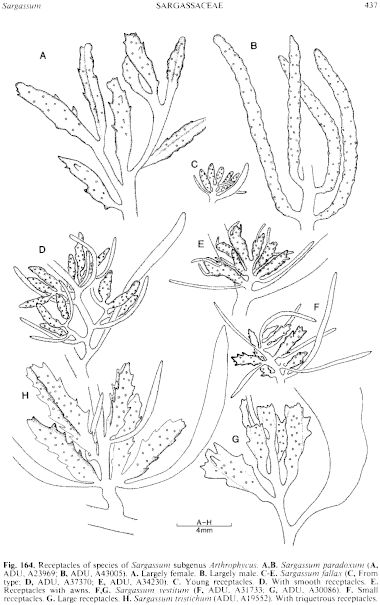|
|
|
|
|
|||||||||||
|
Electronic Flora of South Australia Species Fact Sheet
Phylum Phaeophyta – Order Fucales – Family Sargassaceae
Selected citations: J. Agardh 1848: 298; 1872: 68; 1889: 70, pl. 21 figs 1–7. Grunow 1915: 359.
Synonyms
Fucus vestitus R. Brown ex Turner 1811: pl. 177.
Carpacanthus vestitus (R. Brown ex Turner) Kützing 1849: 625; 1861: 15, p1. 45d-g.
Sargassum heterophyllum sensu Hooker & Harvey 1847: 413.
Sargassum rhyncophorum J. Agardh 1889: 71, pl. 21 figs 8–12.
Thallus (Fig. 162B) dark brown, 10–150 cm long, with a simple or branched stipe 1–4 cm long, terete, 2–4 mm in diameter, with no or slight branch residues, bearing apically 1–4 (–6) primary branches. Holdfast discoid-conical, 5–15 mm across, usually with a single stipe; epilithic. Primary branches 10–50 cm long, axes slender to moderately robust, triquetrous, bearing tristichously arranged, simple (rarely branched) laterals, denuded below on old branches. Laterals (lower) (3–) 5–10 cm long, 0.5–1.5 (–2) cm broad, smooth, margins entire; upper laterals distinctly smaller than lower laterals, 2–4 cm long and 1–3 mm broad (becoming filiform above), smooth, entire, often lost from older fertile branches. Vesicles usually absent, occasionally profuse, clustered, petiolate, ovoid to ellipsoid, (3–) 4–8 mm long, (2–) 3–5 mm in diameter, with a small mucro.
Reproduction: Thalli monoecious. Receptacles (Fig. I 64F,G) bisexual, in open to dense clusters on upper laterals, ( l-)2–3 (–5) mm long and 0.5–1 (–2) mm broad, petiolate, simple, compressed and occasionally slightly triquetrous above, with prominent spines on their upper half and especially at the apex (Fig. 164F,G), with scattered ostioles on the flat surfaces. Conceptacles unisexual or bisexual; oogonia sessile, ovoid, 100–200 µm long and 80–130 Atm in diameter, few per conceptacle; antheridia sessile or on branched paraphyses, ovoid, 15–25 µm long and 8–12 µ in diameter.
Type from Kent Is, Bass Strait (R. Brown); lectotype in BM.
Selected specimens: Seal Bay, Kangaroo I., S. Aust., drift (Womersley, 22.xi.1968; ADU, A32985). Robe, S. Aust., upper sublittoral pools ( Womersley, 20.xii.1953; ADU, A 19141). Port Fairy, Vic., upper sublittoral pools ( Womersley, 24.ii.1967; ADU, A31733-"Marine Algae of southern Australia" No. 59). Bridgewater Bay, Vic., upper sublittoral ( Womersley, 25.i.1967; ADU, A31765). Sorrento, Vic., upper sublittoral (Bennett, Nov. 1949; ADU, A15265). Walkerville, Vic., drift (Womersley, 11.xi.1982; ADU, A55358). Mallacoota Point, Vic., upper sublittoral (Womersley, 12.xi.1982; ADU, A55344). Rocky Cape, N. Tas., upper sublittoral (Gordon, 18.i.1966; ADU, A30060). Cape Sorell, W. Tas., in deep pools (Bennett, 4.ii.1955; ADU, A20595). Wineglass Bay, Freycinet Pen., Tas., upper sublittoral pools (Wollaston & Mitchell, 2.iii.1964; ADU, A27894). Marion Bay, Tas., drift (Gordon, 10.i.1966; ADU, A30086). Quiet Corner, Adventure Bay, Bruny I., Tas., 1–5 m deep (Shepherd, 9.ii.1972; ADU, A41542).
Distribution: From Robe, S. Aust., to Mallacoota Point, Vic., and around Tasmania. Common just below low tide level and in pools on rough-water coasts.
The Seal Bay, Kangaroo I., drift record could be from nearby but the species does not occur generally north of Robe, S. Aust.
Taxonomic notes: Sargassum vestitum is characterised by the smooth, flat, entire, basal laterals, receptacles which become compressed and bear odd spines, and vesicles which (when present) are ovoid to ellipsoid in shape. The receptacles may elongate considerably on older branches but are always irregular in shape and spines, never triquetrous throughout.
Type material in the BM (some ex K) includes specimens labelled "The specimens returned by Mr Turner", and as these agree well with Turner's description and figures, one is selected as lectotype. The specimen actually illustrated by Turner is ex K, under S. heterophyllum (a South African species) with a label "Japan"; Setchell, on an annotation label, has suggested that the label may have been transposed. Hooker & Harvey (1847, p. 413) recorded S. heterophyllum from Tasmania (Gunn) and the specimen (BM ex K) is S. vestitum.
Sargassum rhyncophorum J. Agardh is based on a Meredith specimen from Tasmania (in Herb. Agardh, LD, 2021). The single sheet labelled S. rhyncophorum in Herb. Agardh (from Browns R., Tas., Herb. Oldfield) bears 6 fragmentary specimens, and J. Agardh's description and figures mainly involve the lower two specimens, of which only the right hand one is fertile and bears vesicles; this specimen is selected as lectotype. The upper specimens have dentate or serrate laterals and probably belong to a separate species.
References:
AGARDH, C.A. (1820). Species Algarum. Vol. 1, Part 1, Fucoideae, pp. 1–168. (Lund.)
AGARDH, C.A. (1824). Systema Algarum. (Lund.)
AGARDH, J.G. (1848). Species, Genera et Ordines Algarum. Vol. 1. (Gleerup: Lund.)
AGARDH, J.G. (1872). Till algernes systematik. Ada Univ. lund. 9(8), 1–71.
AGARDH, J.G. (1889). Species Sargassorum Australiae. K. Svenska Vetenskapsakad. Handl. 23(3), 1–133, Plates 1–31.
GRUNOW, A. (1915). Additamenta ad cognitionem Sargassorum. Verh. Zool. -Bot. Wien 65, 329–448.
HOOKER, J.D. & HARVEY, W.H. (1847). Algae Tasmanicae. Lond. J. Bot. 6, 397–417.
KÜTZING, F.T. (1849). Species Algarum. (Leipzig.)
KÜTZING, F.T. (1861). Tabulae Phycologicae. Vol. 11. (Nordhausen.)
TURNER, D. (1811). Fuci sive Plantarum Fucorum Generi a Botanicis Ascriptarum 'cones Descriptiones et Historia. Vol. 3, pp. 1–148, Plates 135–196. (London.)
The Marine Benthic Flora of Southern Australia Part II complete list of references.
Publication:
Womersley, H.B.S. (14 December, 1987)
The Marine Benthic Flora of Southern Australia
Part II
©Board of the Botanic Gardens and State Herbarium, Government of South Australia
Illustrations in Womersley Part II, 1997: FIGS 162B, 164F,G.

Figure 162 enlarge
Fig. 162. A. Sargassum fallax from N. Tasmania (ADU, A55578). B. Sargassum vestuum (ADU, A 19141).

Figure 164 enlarge
Fig. 164. Receptacles of species of Sargassum subgenus Arthrophycus. A,B. Sargassum paradavum (A, ADU, A23969; B, ADU, A43005). A. Largely female. B. Largely male. C–E. Sargassum fallax ( C, From type; D, ADU, A37370; E, ADU, A34230). C. Young receptacles. D. With smooth receptacles. E. Receptacles with awns. F,G. Sargassum vestitum ( F, ADU. A31733; G, ADU, A30086). F. Small receptacles. G. Large receptacles. H. Sargassum tristichum (ADU, A19552). With triquetrous receptacles.

|
Email Contact: State Herbarium of South Australia |

|